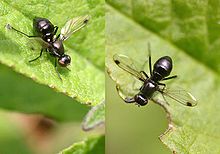| Sepsidae | |
|---|---|

| |
| Sepsis fulgens (lesser dung fly) | |
| Scientific classification | |
| Domain: | Eukaryota |
| Kingdom: | Animalia |
| Phylum: | Arthropoda |
| Class: | Insecta |
| Order: | Diptera |
| Section: | Schizophora |
| Subsection: | Acalyptratae |
| Superfamily: | Sciomyzoidea |
| Family: | Sepsidae Walker, 1833 |
| Genera | |
|
See text | |
The Sepsidae are a family of flies, commonly called the black scavenger flies or ensign flies. Over 300 species are described worldwide.[1] They are usually found around dung or decaying plant and animal material. Many species resemble ants, having a "waist" and glossy black body. Many Sepsidae have a curious wing-waving habit made more apparent by dark patches at the wing end.
Many species have a very wide distribution, reflecting the coprophagous habit of most Sepsidae. Some species have been spread over large territories in association with livestock. Adult flies are found mostly on mammal excrement, including that of humans (less often on other rotting organic matter), where eggs are laid and larvae develop, and on nearby vegetation, carrion, fermenting tree sap, and shrubs and herbs.
Many Sepsidae apparently play an important biological role as decomposers of mammal and other animal excrement. Some species may have a limited hygienic importance because of their association with human feces. Others are useful tools in forensic entomology.